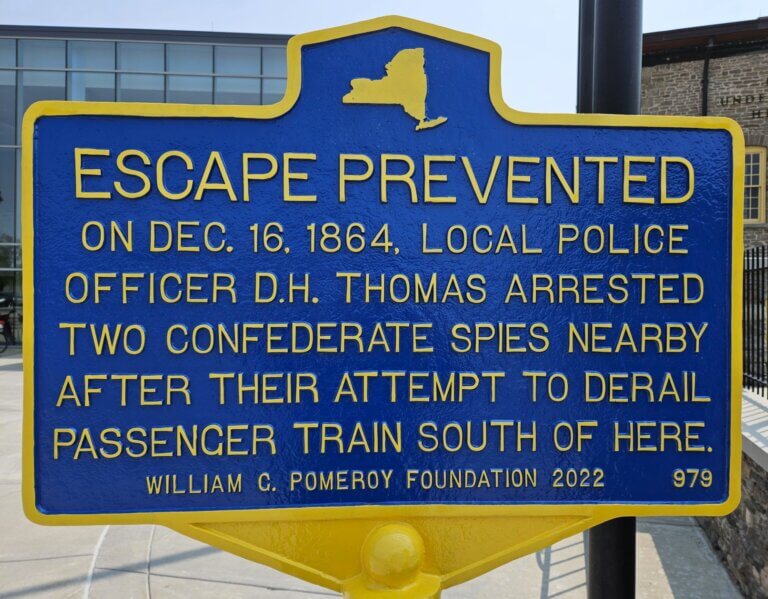ESCAPE PREVENTED
- Program
- Subject
- Location
- Lat/Long
- Grant Recipient
-
NYS Historic
-
Event, Site
- Amtrak Niagara Falls Station, 825 Depot Ave W, Niagara Falls, NY 14305, USA
- 43.109956, -79.055491
-
Niagara Frontier Chapter NRHS, Inc.
ESCAPE PREVENTED
Inscription
ESCAPE PREVENTEDON DEC. 16, 1864, LOCAL POLICE
OFFICER D. H. THOMAS ARRESTED
TWO CONFEDERATE SPIES NEARBY
AFTER THEIR ATTEMPT TO DERAIL
PASSENGER TRAIN SOUTH OF HERE.
WILLIAM G. POMEROY FOUNDATION 2022
“In this that John Y. Beall, a citizen of the insurgent State of Virginia, being without lawful authority, and for unlawful purposes, in the State of New York, did in said State of New York undertake to carry on irregular and unlawful warfare as a guerrilla ; and in the execution of said undertaking, attempted to destroy the lives and property of the peaceable and unoffending inhabitants of said State, and of persons therein travelling, by throwing a train of cars and the passengers in said cars from the railroad track, on the railroad be- tween Dunkirk and Buffalo, by placing obstructions across said track; all this in said State of New York, and on or about the 15th day of December, 1864, at or near Buffalo.” — Trial of John Y. Beall: As a Spy and Guerrillero, by Military Commission (1865)
On December 16, 1864, Officer David H. Thomas of the Niagara City police force was patrolling the passenger depot of the New York Central Railroad Company with his partner when he noticed two men acting suspiciously. Between them sat a canvas bag.
Within an hour the two men were being interrogated and it was soon revealed they were John Y. Beall and George L. Anderson: Confederate spies who, along with a gang of three other men, had recently tried to derail an express passenger train somewhere between Dunkirk and Buffalo New York by obstructing the tracks. Though their attempt would ultimately fail, as would their plan to escape to Canada, the trial transcripts describe more than 1,500 passengers on board the 15-cars they tried to overthrow—a callous disregard for civilian life amidst the tumultuous Civil War. Luckily, though an obstruction was placed across the railway, the train remained on the tracks when it struck the object and was able to slow to a stop. When the men realized their efforts failed, they quickly dispersed. Hoping to make their escape to Canada, Beall and Anderson made their way north to Niagara Falls where they planned to cross the suspension bridge over Niagara River.
Though Officer Thomas would prevent any further exploits, Beall was already an established public enemy of the Union. Initially, Beall was a soldier in the Confederate army in Virginia before being wounded in a skirmish in 1862; following the injury, Beall turned to subterfuge. Throughout the Civil War John Y. Beall operated as a spy and privateer for the Confederacy, primarily operating near the Great Lakes, Potomac and Chesapeake Bay. As was the case of the failed train derailment, often times the target of his attacks were civilians.
Though the two men were arrested together and had operated as a team, it didn’t take long for Anderson to realize the severity of their situation: the war was still underway, he’d been brought in with an infamous antagonist, and, they’d targeted an express train carrying civilians. In an effort to gain leniency in his own sentencing, Anderson agreed to testify against Beall before the military tribunal that would sentence Beall. The decision to try Beall before a military tribunal was the decision of General Dix, who wanted to make an example of Beall.
The testimony proved damning. Not only did Anderson described their attempt to obstruct the track, but as he mentioned, it was one of several efforts. From prying up the track, to just missing the train, Anderson accounted for a continued effort to derail trains in an effort to rob them.
In the end, Beall was convicted and sentenced to execution. Many appealed the conviction to President Lincoln in an effort to overturn the conviction; however, not wanting to undermine his general, Lincoln allowed the conviction to stand. Beall was executed in February of 1865; within two months the Confederacy was defeated.
Though captured near the end of the war, the actions of Officer Thomas likely saved countless lives. He is buried in Oakwood Cemetery.
The marker sits at the location of the former passenger depot where the two spies were arrested, between the Underground Railroad Museum and the Niagara Falls Amtrak within view of the Whirlpool Bridge, which would replace the suspension Bridge Beall and Anderson had hoped to cross.


